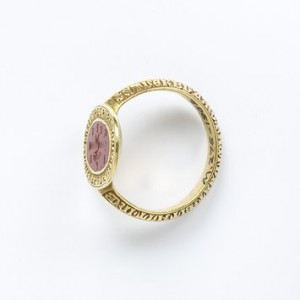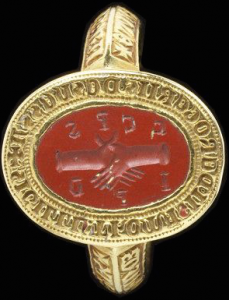Katherine Tycz is a PhD candidate in the Italian Department at the University of Cambridge and a member of the research project funded by the European Research Council, Domestic Devotions the Place of Piety in the Renaissance Italian Home, 1400-1600. Her doctoral research considers the efficacy and materiality of text in early modern Italian devotional practices, and she writes here about an Italian signet ring.
Italian Signet Ring; Victoria & Albert Museum M.275-1962
Stone, 3rd century AD; Ring, 14th century AD
Engraved gold and red jasper stone
An ancient intaglio gem, engraved with clasped hands and the letters ‘CCPS’ and ‘IPD’, found a new life in the fourteenth century when a priest called Tommaso de Rogerii repurposed it to serve as his personal seal. The symbol of intertwined hands represented an agreement that had been sealed by a handshake, and thus also acquired connections with vows—whether made in lay marriages or in agreement to religious life. Not only etched in stone, but also appearing on rings moulded out of metal, this symbol remained popular throughout the early modern period across Europe. Eventually the rings became known by collectors as fede rings, after the Italian term for the clasped-hands symbol (mani in fede), reflecting their representation of a faithful agreement or alliance.
Embedded in a rich gold ring, the gem’s image would be pressed in molten wax, revealing the reverse of the image, to seal important documents from the desk of the priest. Arranged around the edge of the gem, another inscription identified Tommaso as the ring’s owner: ‘SIGILLU. THOMASII.DE. ROGERII S.DESUESSA [The seal of Tommaso de Rogerii, priest of Suessa]’. Allegedly found in the church of Santa Maria in Commedia in Sessa [Suessa] Aurunca, a hamlet near Naples, in the mid-nineteenth century, this ring may have been used by the church’s priests as a signet ring throughout the centuries. Or perhaps it was left in the church as a votive offering by Tommaso.
Other inscriptions reveal other facets of the ring’s function; embossed around the band in parallel rows are the words, ‘+ ET VERBU: CARO. FACTU: E:ET ABITANT:/ NOB [and the word was made Flesh and he dwelt among us]’ and ‘/+ XPS VINCIT X XPS X REGNAT X XPS: IMPERA [Christ conquers, Christ reigns, Christ rules]’.
 A longer excerpt from the Gospel of John [‘Verbum caro factum est’] has been inscribed on this ring. Not only is the moment of the incarnation of the Word captured here, but also the continuing presence of God’s Word on Earth through Jesus. The paired inscription, ‘Christ conquers, Christ reigns, Christ rules’, further explains the omnipotent role of Christ in Christian belief. Taken literally, both inscriptions reflect the Christian identity of the ring’s owner. Further, the use of the Verbum caro citation on a tool utilised in the act of writing and sealing is particularly evocative.
A longer excerpt from the Gospel of John [‘Verbum caro factum est’] has been inscribed on this ring. Not only is the moment of the incarnation of the Word captured here, but also the continuing presence of God’s Word on Earth through Jesus. The paired inscription, ‘Christ conquers, Christ reigns, Christ rules’, further explains the omnipotent role of Christ in Christian belief. Taken literally, both inscriptions reflect the Christian identity of the ring’s owner. Further, the use of the Verbum caro citation on a tool utilised in the act of writing and sealing is particularly evocative.
However, these two phrases also hold other, more occult meanings. Individually, each phrase holds amuletic power. Both expressions were employed for protective purposes on a variety of objects throughout Europe, and were especially common on wearable amulets, such as rings, pendants, and also a type of parchment or paper prayer sheet that would be sealed in a pouch and worn on the body. The red jasper stone, a type that had long been used for protective and curative purposes, also gained power from its ancient origins. In combination with the jasper, the efficacy of these religious and apotropaic inscriptions would be enhanced for the ring’s wearer.
Images: Victoria & Albert Museum
